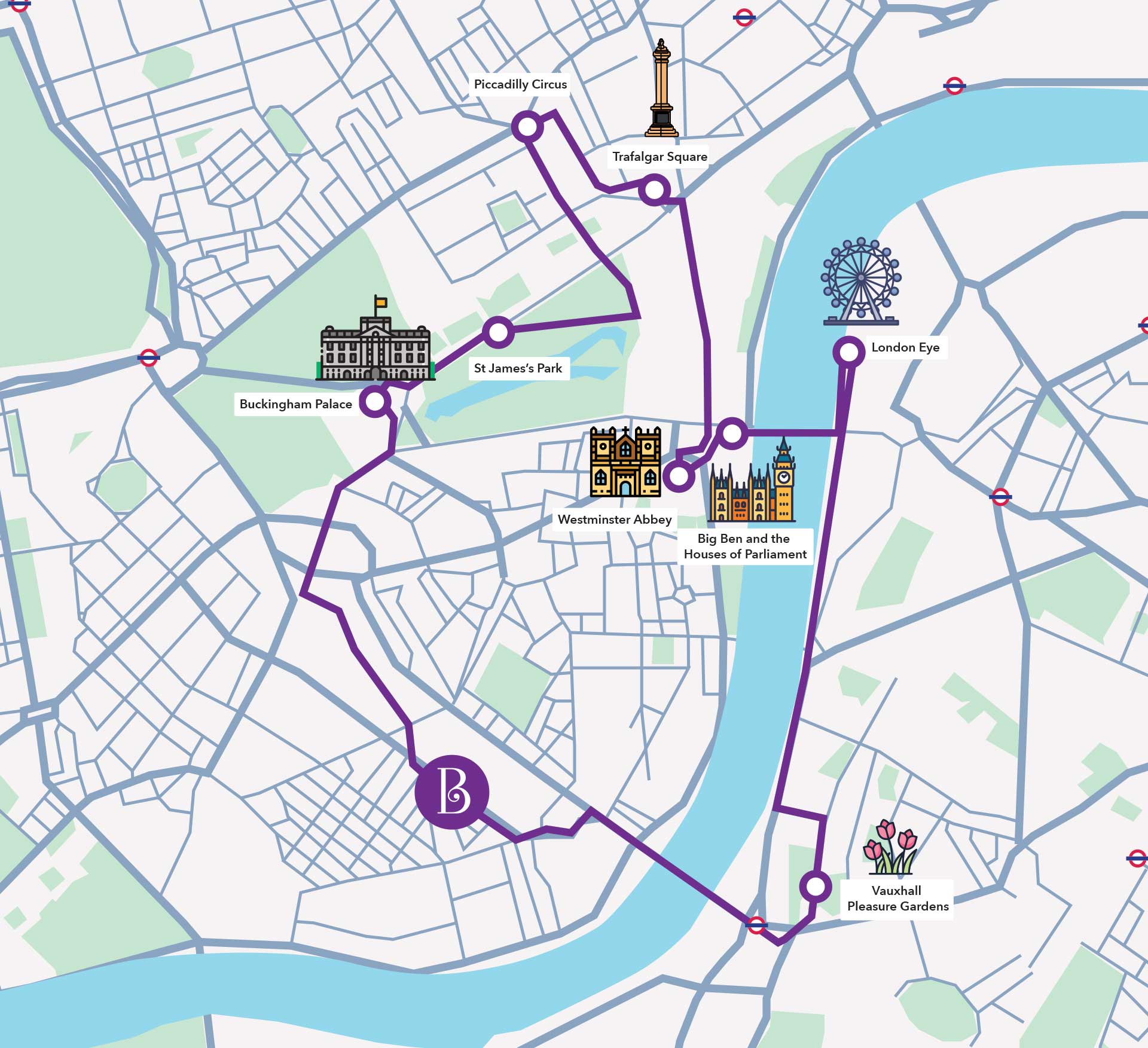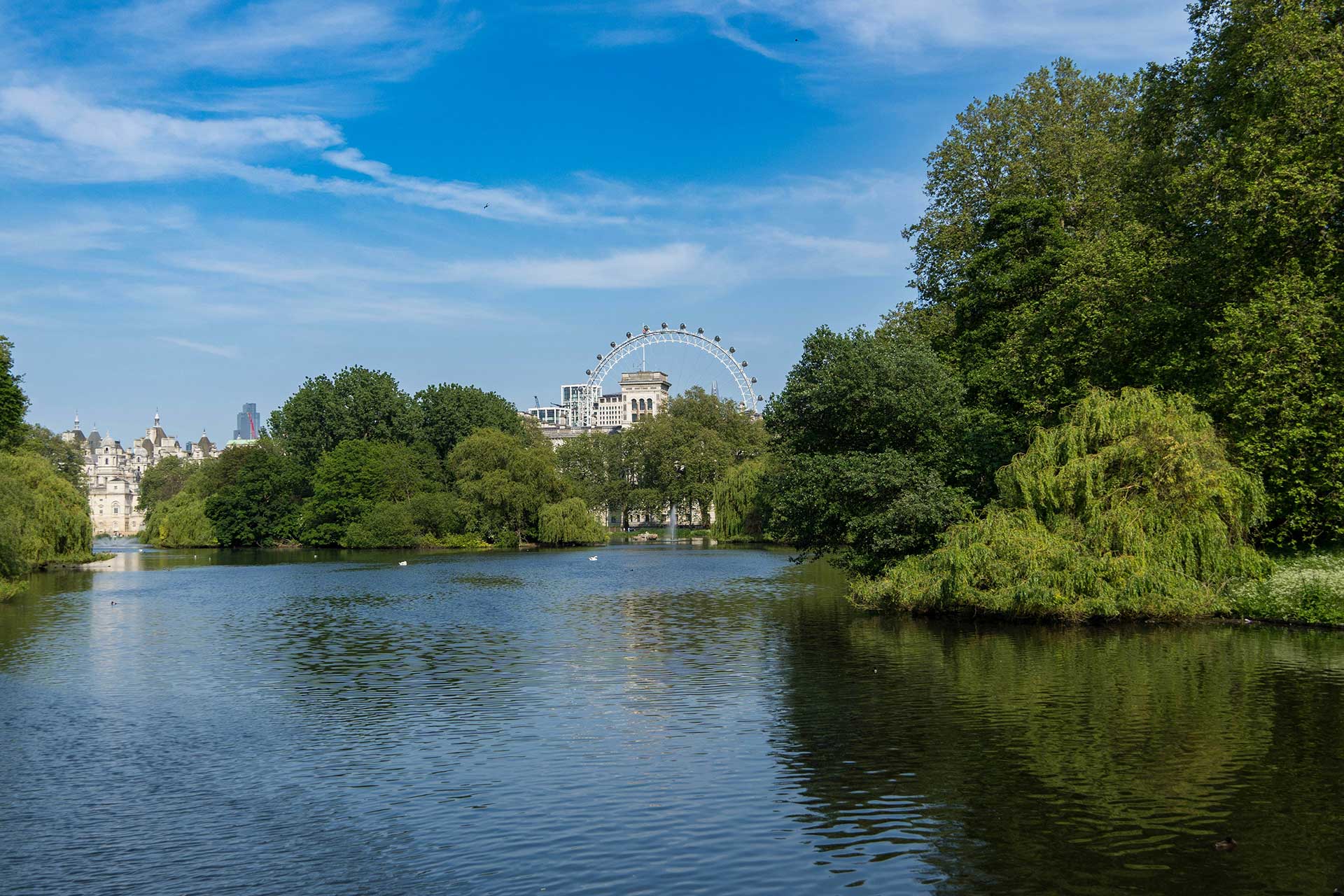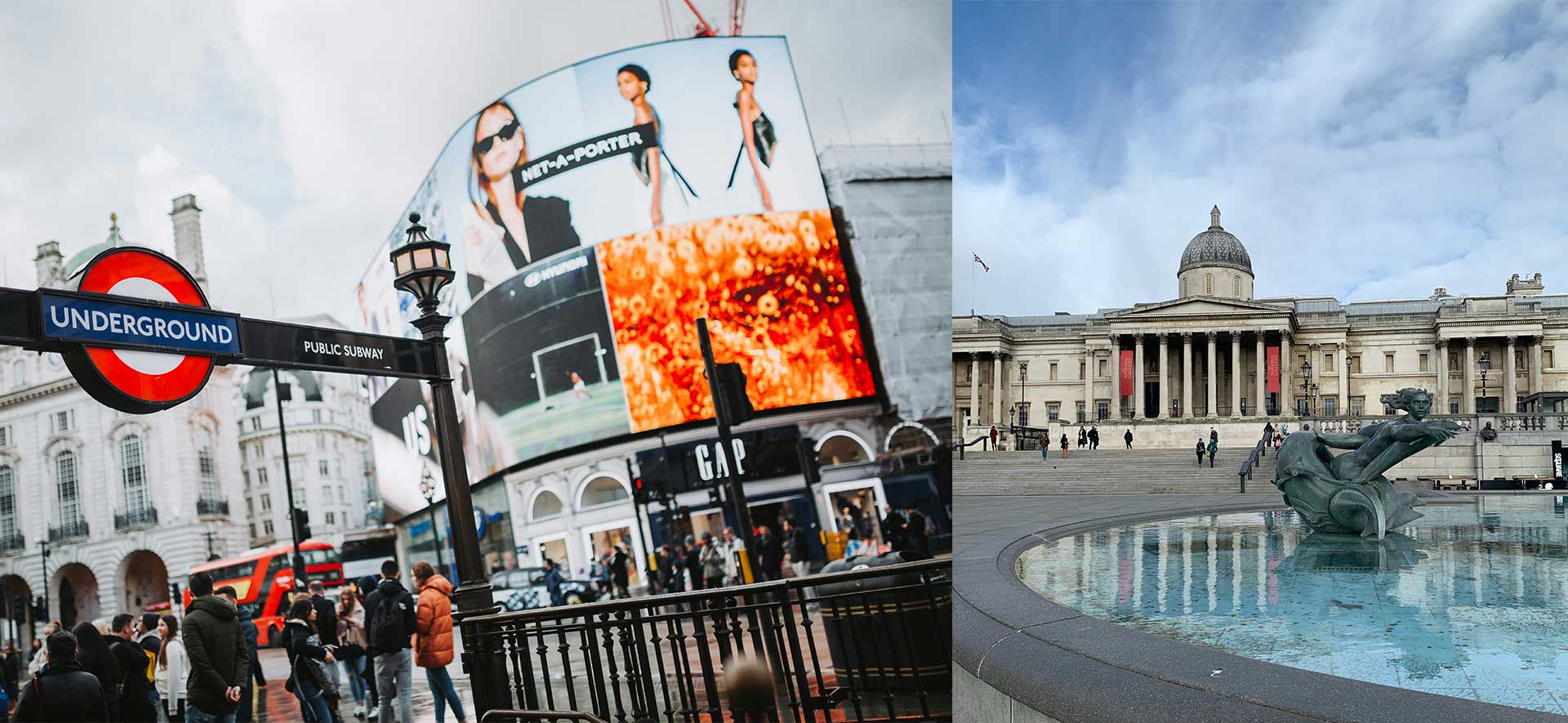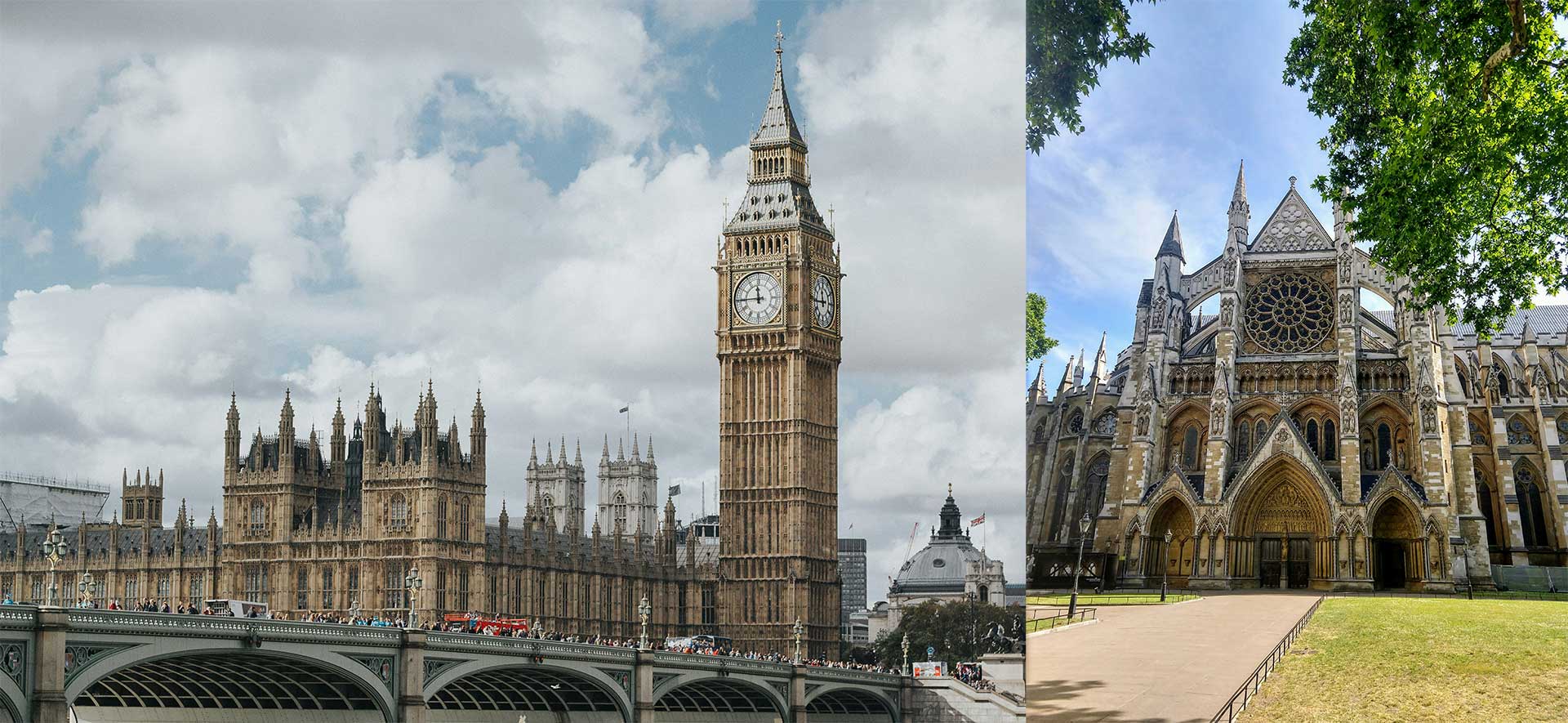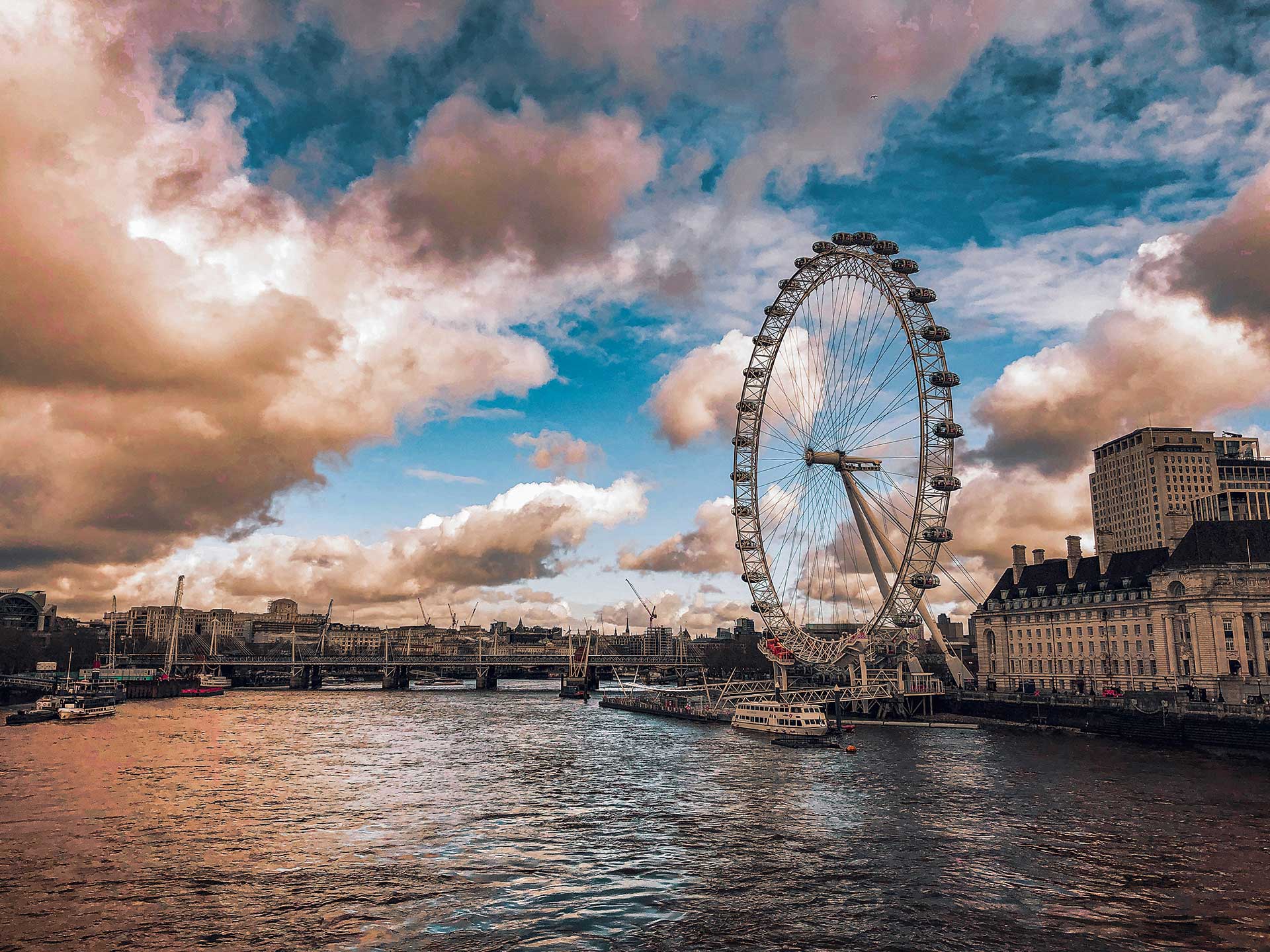Our historical walking route around London
 “>
“>As the weather slowly begins to warm up (Spring, you’re welcome to arrive at any time!), we love getting back out into the fresh air and going for walks around London. Luckily, our great location means you can head out and go and see a lot of the big sights of London without having to use any public transport, as long as you don’t mind a bit of a walk!
We have plotted a route below you can use as you wish, add to it or shorten it as needed depending on what you want to see. The walk takes in the major sights of London, including Big Ben and the Houses of Parliament, Westminster Abbey and Buckingham Palace and offers plenty of pit stops along the way. As this is a historical walk, we’re going to give you a bitesize history lesson about each sight you’ll see. See the full route on Google Maps.
Let’s go for a walk
The route takes you on a loop of London, so once you come out of the hotel, take a left and walk down the road to the junction of Buckingham Palace Road. Turn right and head towards Buckingham Palace for our first stop.
Buckingham Palace
This is the Royal residence in London, and this monumental building was originally built as a large townhouse for the Duke of Buckingham in 1703 after being privately owned land for over 150 years. However, it had started off as a small set of land forming part of the Manor of Ebury in the Middle Ages, it was owned by various people, from Edward the Confessor and Edith of Wessex to William the Conqueror. Henry VIII bought the Manor from Westminster Abbey in 1536, and it stayed under royal control until James I sold off a part of the site for the money he needed, retaining some land to establish a mulberry garden for silk production.
Bridgerton fans will know that King George III bought the house for Queen Charlotte to help make her feel better after moving here from a small German duchy in 1761, and it soon became known as ‘The Queen’s House’. It was enlarged in the 19th and 20th centuries, including adding the famous balcony we see during special occasions.
In World War II, the palace was famously hit during a bombing raid which destroyed the royal chapel. This site was repurposed into the now-called King’s Gallery in the 1960s as a public place to showcase works of art from the royal collection.
Today, Buckingham Palace is undergoing major renovation and eventually planned as the main residence of King Charles III and Queen Camilla. It is not just a fully functioning home anymore, though; it has art galleries that are open to the public and is the main symbol of the British Monarchy. Take a wander around and head up to the Victoria Monument to take in the palace in all its glory.
St James’s Park
After your brief stop at Buckingham Palace to wave hello to their Royal Highnesses (if they are in), walk back slightly down Birdcage Walk and head into St James’s Park.
It’s hard to believe that just under 500 years ago, this whole area was marshland acquired by Henry VIII to turn into a hunting park where St James Palace was built as Henry’s hunting lodge. When James I succeeded to the throne, he had it drained and turned into an exotic zoo.
It was then landscaped again in the French style once Charles II was crowned, with a large canal in the middle of it. It became somewhere that Charles took his many mistresses and soon developed quite the reputation for being a place of disrepute!
In the middle of the 18th century, it was transformed again as some of the canal was given to the Horse Guards Parade and the rest was turned into a walking garden when Buckingham Palace was bought by King George III.
It’s a delightful stroll around the park no matter what the season. You can use your time to wander around, maybe have a little picnic or just take in the beauty that you can find in Central London.
To continue the walk, you’ll need to leave the park at the Horse Guard’s Road entrances – if you leave at the bottom entrance, you’ll walk past the Imperial War Museum Churchill’s War Rooms.
Head up Horse Guard’s Road until you reach the Mall (where London Marathoners realise they’ve so very nearly finished 26.2 miles around London), take a left down Cockspur Street, saying ‘hi’ to Nelson in Trafalgar Square and then head on to Haymarket Street before you reach our next stop: Piccadilly Circus.
Piccadilly Circus and Trafalgar Square
One of the busiest places to be in London, but Piccadilly Circus is part of the main shopping district, you can get to Covent Garden, Shaftesbury Avenue, Oxford Street, Soho and the West End from here.
You’ll pass Trafalgar Square on your way through – which is a commemoration of the Battle of Trafalgar. This was a naval battle during the Napoleonic Wars where Britain was victorious. The battle took place off the coast of Cape Trafalgar, in southern Spain in 1805. The square was not named Trafalgar Square until around 1835.
Trafalgar Square houses Nelson’s Column, Nelson was the admiral who led Britain to victory during the battle, which is a whopping 169 feet and 3 inches (51.59m) tall. The column was completed and installed in 1843 by architect William Railton after a competition was held.
Trafalgar Square is famous for its New Year celebrations, its Christmas Tree and for being a space for political activism.
There are also many, many pigeons.
Once you’ve taken in Trafalgar Square, you can walk down to Piccadilly Circus where you’ll see the famous screens where advertisers vie to get their brands seen.
Originally known as Portugal Street in a nod to Catherine of Braganza, Charles II’s queen consort, it was known as Piccadilly by 1743. It has also always been one of the busiest roads for traffic since it was created as it was in the centre of two very famous places throughout the 17th to 19th centuries; Covent Garden and Theatreland.
It’s great to just wander around Piccadilly Circus, and take in the sights before you walk back the way you came. Once you get back to Trafalgar Square, you’ll head straight past the Equestrian Statue of King Charles I and walk down Whitehall.
Westminster Abbey, Big Ben and the Houses of Parliament
Walking down Whitehall may look familiar, as it’s where the administrative arm of the UK government is. You’ll go past Downing Street, where No 10 has been the official residence for the Prime Ministers since 1735, Whitehall, and the Cenotaph before you reach Big Ben, the Houses of Parliament and Westminster Abbey.
Let’s start with Big Ben facts. The tower itself is not Big Ben! It’s actually the Elizabeth Tower, so called after Queen Elizabeth II, and renamed in 2012 for her Diamond Jubilee. Built in 1843, it was part of the new design for the Palace of Westminster and was completed in 1859. It stands proudly as part of London’s sightseeing skyline and has recently undergone renovations where the clock didn’t chime between 2017 and 2021, which was extremely eerie!
Big Ben is attached to the Houses of Parliament, where both branches of the UK Government sit; the Lords and MPs. The building was originally a royal palace for Edward the Confessor in the 11th century and was remodelled and enlarged by William the Conqueror. Unfortunately, this structure was partially destroyed by a fire in 1512 and it was decided to no longer use it as a royal palace. In 1834, as mentioned above, the main part of the building was again destroyed by a fire, except Westminster Hall, the Jewel Tower, and the crypt of St. Stephen’s Chapel. The works were completed by 1860 and that is the fantastic building that we see today on the banks of the River Thames. As the place where the House of Lords and the House of Commons are located, it is no surprise that this is the main centre of political life in the UK. The building (formally known as Westminster Palace) is also a UNESCO World Heritage Site and one of the main tourist attractions in London, despite general members of the public not having access inside.
Once you’ve passed Big Ben and the Houses of Parliament, then walk straight down Abingdon Street to see Westminster Abbey, one of the oldest buildings in London, and where every monarch since William I has been crowned, except for Edward V and Edward VIII and is a nod to the pomp and pageantry that Britain is known for throughout its history.
There has been a church on the site of the Abbey since the 1000s, and it was rebuilt by Henry III in the 13th century. As well as coronations and royal weddings, the Abbey is also a place of burial. The shrine of Edward the Confessor is a magnificent tomb behind the High Altar and is surrounded by medieval kings and queens, including Henry III, Edward I and Eleanor of Castile and Henry V to name a few. The Abbey is also home to 600 monuments and wall tablets and one of the most famous burials is the ‘Unknown Warrior’, whose grave has become a place of pilgrimage for many.
The Abbey is open most days, but as a working church, please be mindful of certain days when the Abbey may have to be closed to the public. It’s an astonishing piece of architecture and history that is definitely worth a moment or two of your time.
The London Eye
After the Abbey, cross Lambeth Bridge and turn right to get to our next stop.
Possibly the youngest entry on the list, the London Eye is no less worthy of a mention on our historical walk.
It is the tallest cantilevered observation wheel in Europe and hosts over three million visitors per year, making it the most popular paid tourist attraction in the UK. It opened in 2000 as part of the Millennium celebrations and still remains as popular 25 years on.
The wheel has 32 sealed and air-conditioned ovoid capsules, each of which represents one of the London Boroughs and can hold up to 25 people. If you look closely at the numbers, you’ll notice it counts to 33, that is because 13 was omitted due to superstition. In 2020, the London Eye famously celebrated its 20th birthday by turning some of the pods into London-themed experiences such as a theatre pod, a garden party, and a pub. It only takes 30 minutes for the rotation, so grab a ticket if you have time and enjoy the ride!
You’ve nearly done your whistlestop tour of London! The last stop is a bit further down the embankment, Vauxhall Gardens.
Vauxhall Pleasure Gardens
Not just a regular park with football pitches and a horse-riding route, Vauxhall Pleasure Gardens was famous for its wild parties in the 18th and 19th centuries.
Originally this park was known as the New Spring Gardens, and opened before the Restoration of 1660. It was popular for public entertainment with food and drinks vendors flocking to the site to take advantage of young debutantes and bachelors who were willing to part with their money. Those wanting to go to the gardens before 1810 would commandeer boats to take them across the Thames before Vauxhall Bridge was built.
The gardens were a place to see and be seen, it has been represented throughout the years in books, TV shows and films as the place to go for an evening for the younger crowd to get away from the prying eyes of the Ton.
Nowadays, it’s a far cry from the whirlwind of parties, dancing and entertainment that it once was, but it’s ideal for a leisurely walk around, playing some football with friends or family or having a quick break before heading back to your hotel.
When you’re ready, leave the park and head to Vauxhall Bridge. Once over the bridge, keep walking on Vauxhall Bridge Road, until you get to the junction with Drummond Gate, take this road and then after a short walk, you can turn right back onto Belgrave Road and back to The Belgrave Hotel where you can rest your legs and get a well-earned cup of tea.

